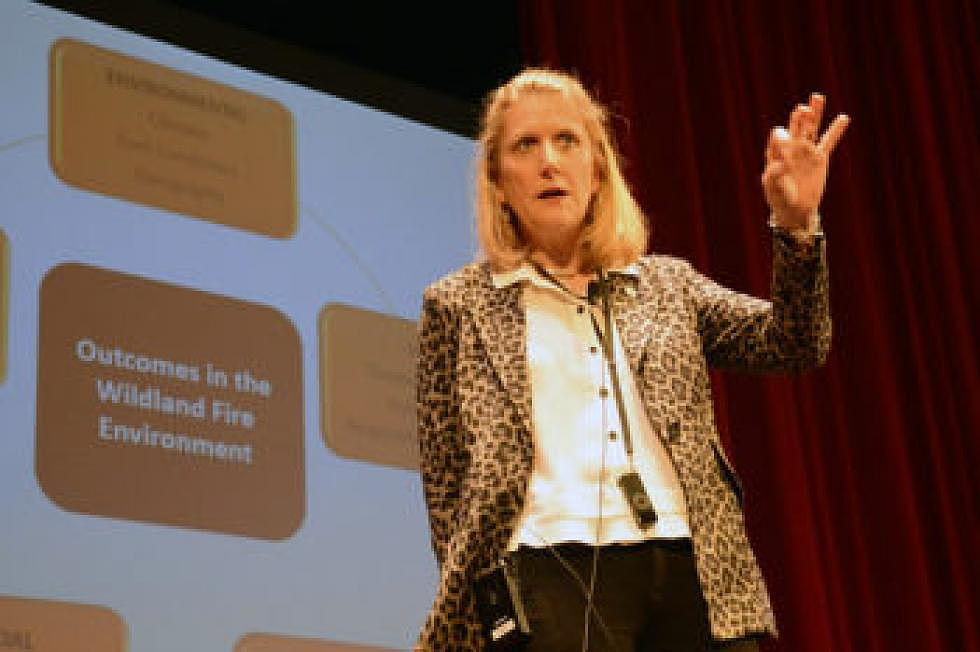
‘No blank checks': New Forest Service chief says firefighting must become more efficient
As she inherits an agency hamstrung by the skyrocketing cost of fighting wildfires, the interim chief of the U.S. Forest Service is encouraging her charges to plan differently for future fire seasons.
“If we think what worked for us for the last 100 years is going to work for us the next 100 years, we might as well fold and go home because I don’t see success,” said Vicki Christiansen, who was named the agency’s interim leader two months ago.
On Monday, Christiansen addressed hundreds of firefighters, scientists and land managers from across the globe as a keynote speaker at the 24th annual Fire Continuum Conference at the University of Montana.
Ticking off the realities that complicate firefighting – longer fire seasons, bigger and more severe fires, a warming climate and more homes being built in the wildland-urban interface – Christiansen said the Forest Service faces “gnarly” challenges.
But almost 10 years ago, agency wildfire experts set out to develop a new national strategy for dealing with the expanding threat.
In 2014, they presented the Cohesive Strategy with three goals: restore healthy forests, create fire-adapted communities and develop an effective, safe, risk-based response.
That means evaluating landscapes and creating possible plans of action before fires begin to burn.
All three goals need to be achieved – and soon, preferably before the next megafire, Christiansen said Monday.
That’s how the strategy provides a framework for controlling those gnarly challenges, reducing the billions of dollars spent on firefighting and the associates loss of life.
“Tragically, the number of wildland firefighter fatalities is rising,” said Christiansen, herself a former firefighter. “Since 1910, there have been more than 1,000 fatalities. Almost one-quarter, 255, occurred in the last 15 years.
“Safety is our highest priority. No home is worth a human life.”
Christiansen was named interim chief in March after her predecessor, Tony Tooke, resigned amid sexual harassment allegations. A month later, she received word that Congress had finally adjusted its method for allocating fire suppression funds.
In the Omnibus budget bill, Congress gave the Forest Service and Interior Department badly needed stability by allocating funds specifically for the task of fighting wildfires.
In the past, if the cost of fighting fires exceeded the agency’s budget, other Forest Service projects such as maintenance would be abandoned as money was siphoned off to make up the difference.
Under the so-called fire funding fix, starting in 2020, Congress can allocate up to $2.25 billion for fire suppression, increasing to almost $3 billion over eight years. In the meantime, Congress can allocate up to $1.9 billion annually.
In an effort to prepare for wildfires, the fix adds $80 million for thinning and prescribed burning, and creates a process where the Forest Service can thin areas up to 3,000 acres without having to open the project to public comment.
“By giving us these new tools and more funds along with the fire funding fix, the Omnibus will help us stabilize our programs,” Christiansen said. “It will also extend our ability to work with partners under the cohesive strategy to meet our shared goals – help us learn to live with wildland fire. But it comes with a caveat: No blank checks.”
Christiansen cautioned her employees that they must show Congress they can fight fires more efficiently, which may include letting a few burn. The best way to do that is to identify those areas ahead of time and to develop ways to evaluate the agency’s performance.
Otherwise, Congress may not be as generous 10 years from now.
“With new opportunities comes the challenge of living up to the expectations of the people we serve,” Christiansen said. “Our success will vindicate the trust that Congress has placed in us.”
The Fire Continuum Conference continues through Thursday at UM, with hundreds of individual sessions and an expected 800 participants.
The conference is an annual international meeting of firefighters, fire ecologists and wildfire managers that covers the spectrum of wildfire issues from planning and prevention to fighting fires and restoration. Co-sponsored by the Association for Fire Ecology and the International Association of Wildland Fire, the 2019 conference will be held in Arizona.
